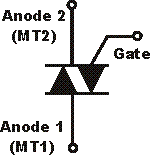What is a Triac?
- a summary or overview describing what is a triac, and detailing ways of using triacs and some triac circuits.
Triacs are widely used in AC power control applications. They are able to switch high voltages and high levels of current, and over both parts of an AC waveform. This makes triac circuits ideal for use in a variety of applications where power switching is needed. One particular use of triac circuits is in light dimmers for domestic lighting, and they are also used in many other power control situations including motor control.
The triac is a development of the thyristor. While the thyristor can only control current over one half of the cycle, the triac controls it over two halves of an AC waveform. As such the triac can be considered as a pair of parallel but opposite thyristors with the two gates connected together and the anode of one device connected to the cathode of the other, etc..
Triac symbol
The basic triac symbol used on circuit diagram indicates its bi-directional properties. The triac symbol can be seen to be a couple of thyristor symbols in opposite senses merged together.

Triac symbol for use in circuit diagrams
Like a thyristor, a triac has three terminals. However the names of these are a little more difficult to assign, because the main current carrying terminals are connected to what is effectively a cathode of one thyristor, and the anode of another within the overall device. There is a gate which acts as a trigger to turn the device on. In addition to this the other terminals are both called Anodes, or Main Terminals These are usually designated Anode 1 and Anode 2 or Main Terminal 1 and Main Terminal 2 (MT1 and MT2). When using triacs it is both MT1 and MT2 have very similar properties.
How does a triac work?
Before looking at how a triac works, it helps to have an understanding of haow a thyristor works. In this way the basic concepts can be grasped for the simpler device and then applied to a triac which is more complicated. The operation of the thyristor is covered in the article in this section and accessible through the "Related Articles" box on the left of the page and below the main menu.
For the operation of the triac, it can be imagined from the circuit symbol that the triac consists of two thyristors in parallel but around different ways. The operation of the triac can be looked on in this fashion, although the actual operation at the semiconductor level is rather more complicated.

Equivalent circuit of a triac
When the voltage on the MT1 is positive with regard to MT2 and a positive gate voltage is applied, one of the thyristors conducts. When the voltage is reversed and a negative voltage is applied to the gate, the other thyristor conducts. This is provided that there is sufficient voltage across the device to enable a minimum holding current to flow.
Using triacs
there are a number of points to note when using triacs. Although these devices operate very well, to get the best performance out of them it is necessary to understand a few hints on tips on using triacs.
It is found that because of their internal construction and the slight differences between the two halves, triacs do not fire symmetrically. This results in harmonics being generated: the less symmetrical the triac fires, the greater the level of harmonics that are produced. It is not normally desirable to have high levels of harmonics in a power system and as a result triacs are not favoured for high power systems. Instead for these systems two thyristors may be used as it is easier to control their firing.
To help in overcoming the problem non-symmetrical firing ad the resulting harmonics, a device known as a diac (diode AC switch) is often placed in series with the gate of the triac. The inclusion of this device helps make the switching more even for both halves of the cycle. This results from the fact that the diac switching characteristic is far more even than that of the triac. Since the diac prevents any gate current flowing until the trigger voltage has reached a certain voltage in either direction, this makes the firing point of the triac more even in both directions.
Overview of using triacs
Triacs are ideal devices for use in many AC small power applications. Triac circuits for use as dimmers are widespread and they are simple and easy to implement. When using triacs, diacs are often included in the circuit as mentioned above to help reduce the level of harmonics produced.
|
|







0 comments:
Post a Comment